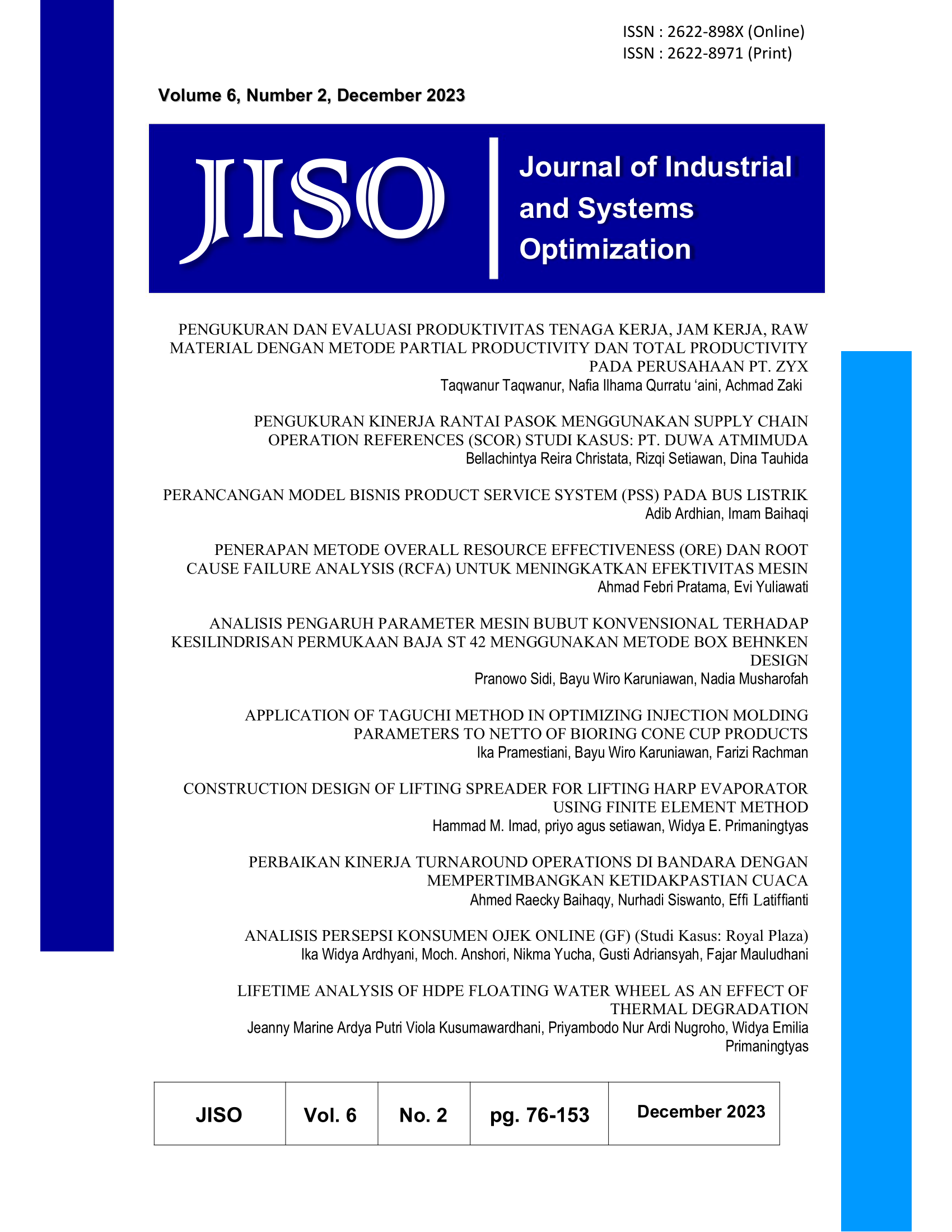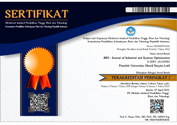PERBAIKAN KINERJA TURNAROUND OPERATIONS DI BANDARA DENGAN MEMPERTIMBANGKAN KETIDAKPASTIAN CUACA
DOI:
https://doi.org/10.51804/jiso.v6i2.131-139Keywords:
turnaround operations, ketidakpastian cuaca, simulasiAbstract
Aviation has become an important aspect in human life thanks to its ability to transport people to faraway places with short duration and relatively low cost. However, aviation activities are highly influenced by uncertain events such as weather conditions. One of the activities that is impacted by these 2 events is turnaround operations. Turnaround operations is an activity performed to prepare aircraft for the next flight. This research aims to evaluate and improve turnaround operations performance both from relative duration tardiness (?T%) and on-time performance (OTP) using discrete-event simulation approach. Results obtained from simulation model show that the value of ?T% is 43.48% and OTP of 54.20%. Improvement scenarios are developed by arranging the new ground support staff (GSS) schedule and allocation as well as adding GSS at a certain rate. Scenario of implementing new schedule and allocation and adding GSS with rate of 50% comes out as the selected scenario which could improve ?T% and OTP performance to become 33.35% and 54.91% respectively.
Aviasi telah menjadi aspek yang penting bagi manusia karena kemampuannya untuk membawa manusia ke tempat yang jauh dengan durasi singkat dan biaya yang relatif rendah. Akan tetapi, kegiatan aviasi sangat dipengaruhi oleh kejadian yang tak pasti seperti kondisi cuaca. Salah satu kegiatan yang terdampak oleh kedua kejadian ini adalah turnaround operations. Turnaround operations merupakan kegiatan yang dilakukan untuk mempersiapkan pesawat untuk penerbangan selanjutnya. Penelitian ini bertujuan untuk mengevaluasi dan memperbaiki kinerja turnaround operations baik dari sisi durasi keterlambatan relatif (?T%) maupun on-time performance (OTP) menggunakan pendekatan simulasi kejadian diskrit. Hasil yang diperoleh dari model simulasi menunjukkan bahwa nilai ?T% sebesar 43.48% dan OTP sebesar 54.20%. Skenario perbaikan dikembangkan dengan menyusun penjadwalan dan alokasi ground support staff (GSS) yang baru dan penambahan GSS dengan tingkat tertentu. Skenario dengan menerapkan jadwal dan alokasi baru serta penambahan GSS sebesar 50% keluar sebagai skenario terpilih yang mampu memperbaiki nilai ?T% dan OTP menjadi 33.35% dan 54.91% secara berturut-turut.
References
Borsky, S., & Unterberger, C. (2019). Bad weather and flight delays: The impact of sudden and slow onset weather events. Economics of Transportation, 18, 10–26. https://doi.org/10.1016/j.ecotra.2019.02.002
Chen, Z., & Wang, Y. (2019). Impacts of severe weather events on high-speed rail and aviation delays. Transportation Research Part D: Transport and Environment, 69, 168–183. https://doi.org/10.1016/j.trd.2019.01.030
Dalmau, R., & Gawinowski, G. (2024). The effectiveness of supervised clustering for characterising flight diversions due to weather. Expert Systems with Applications, 237. https://doi.org/10.1016/j.eswa.2023.121652
Harrel, C., Gosh, B. K. & Bowden, R. O. (2004). Simulation Using Promodel. 2nd ed. California: Mc. Graw Hill.
Hoover, S., & Perry, R. (1990). Simulation: A Problem Solving Approach. Massachusetts: Addison-Wesley.
Jarošová, M., & Pajdlhauser, M. (2022). Aviation and Climate Change. Transportation Research Procedia, 65(C), 216–221. https://doi.org/10.1016/j.trpro.2022.11.025
Kulesa, G. (2002). Weather and Aviation: How Does Weather Affect the Safety and Operations of Airports and Aviation, and How Does FAA Work to Manage Weather-related Effects? The Potential Impacts of Climate Change on Transportation.
Lai, J., Che, L., & Kashef, R. (2021, September 7). Bottleneck Analysis in JFK Using Discrete Event Simulation: An Airport Queuing Model. 2021 IEEE International Smart Cities Conference, ISC2 2021. https://doi.org/10.1109/ISC253183.2021.9562823
Lui, G. N., Hon, K. K., & Liem, R. P. (2022). Weather impact quantification on airport arrival on-time performance through a Bayesian statistics modeling approach. Transportation Research Part C: Emerging Technologies, 143. https://doi.org/10.1016/j.trc.2022.103811
Malandri, C., Mantecchini, L., Paganelli, F., & Postorino, M. N. (2020). Impacts of unplanned aircraft diversions on airport ground operations. Transportation Research Procedia, 47, 537–544. https://doi.org/10.1016/j.trpro.2020.03.129
Malighetti, P., Morlotti, C., Redondi, R., & Paleari, S. (2022). The turnaround tactic and on-time performance: Implications for airlines’ efficiency. Research in Transportation Business and Management. https://doi.org/10.1016/j.rtbm.2022.100874
Mota, M. M., Boosten, G., de Bock, N., Jimenez, E., & de Sousa, J. P. (2017). Simulation-based turnaround evaluation for Lelystad Airport. Journal of Air Transport Management, 64, 21–32. https://doi.org/10.1016/j.jairtraman.2017.06.021
de Oliveira, M., Eufrásio, A. B. R., Guterres, M. X., Murça, M. C. R., & Gomes, R. de A. (2021). Analysis of airport weather impact on on-time performance of arrival flights for the Brazilian domestic air transportation system. Journal of Air Transport Management, 91. https://doi.org/10.1016/j.jairtraman.2020.101974
Qualley, W. L., (1997). Impact of Weather on and use of Weather Information by Commercial Airline Operations. Workshop on the Social and Economic Impacts of Weather. https://sciencepolicy.colorado.edu/socasp/weather1/qualley.html
Rodríguez-Sanz, Á., Cano, J., & Rubio Fernández, B. (2022). Impact of weather conditions on airport arrival delay and throughput. Aircraft Engineering and Aerospace Technology, 94(1), 60–78. https://doi.org/10.1108/AEAT-12-2020-0318
San Antonio, A., Juan., A. A., Casas, P. F., Calvet, L., Guimarans., D. (2017). Using Simulation to Estimate Critical Paths and Survival Functions in Aircraft Turnaround Processes. Proceedings of the 2018 Winter Simulation Conference.
Wignall, A. (2022). How it works: the aircraft turnaround. https://www.aerotime.aero/articles/32767-how-it-works-the-aircraft-turnaround
Wu, C. L., & Caves, R. E. (2004). Modelling and optimization of aircraft turnaround time at an airport. Transportation Planning and Technology, 27(1), 47–66. https://doi.org/10.1080/0308106042000184454
Wu, C. L., & Caves, R. E. (2004). Modelling and simulation of aircraft turnaround operations at airports. Transportation Planning and Technology, 27(1), 25–46. https://doi.org/10.1080/0308106042000184445
Yan, S., & Chen, Y. C. (2021). Flight rescheduling, fleet rerouting and passenger reassignment for typhoon disruption events. Transportation Letters. https://doi.org/10.1080/19427867.2021.1950266
Zhou, L., & Chen, Z. (2020). Measuring the performance of airport resilience to severe weather events. Transportation Research Part D: Transport and Environment, 83. https://doi.org/10.1016/j.trd.2020.102362
Downloads
Published
Issue
Section
License
Copyright (c) 2023 JISO : Journal of Industrial and Systems Optimization

This work is licensed under a Creative Commons Attribution-ShareAlike 4.0 International License.
With the receipt of the article by JISO Editorial Board and the decision to be published, the copyright regarding the article will be transferred to JISO. The copyright transfer form can be downloaded here.
JISO has the right to multiply and distribute the article and every author is not allowed to publish the same article that was published in this journal.
JISO is licensed under a Creative Commons Attribution-ShareAlike 4.0 International License.
Under the following terms:
Attribution — You must give appropriate credit, provide a link to the license, and indicate if changes were made. You may do so in any reasonable manner, but not in any way that suggests the licensor endorses you or your use.
ShareAlike — If you remix, transform, or build upon the material, you must distribute your contributions under the same license as the original.














